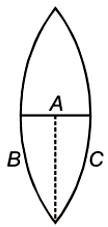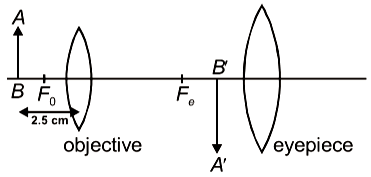The minimum distance between a real object and screen such that a convex lens of focal length 20 cm can produce a real image on the screen is.
1. 20 cm
2. 40 cm
3. 80 cm
4. 60 cm
A biconvex lens of glass has a radius of curvature 20cm. Which one of the following gives the correct position and nature of the image formed when an object is placed at 40cm from the lens?
1. Real, inverted and same size
2. real, inverted and diminished
3. Real, inverted and enlarged
4. Virtual, upright and enlarged
A converging beam of light is incident on a concave lens of focal length 30cm, in such a way that their point of intersection would lie at a height 1cm above the principal axis and at a distance of 24cm from the position of the lens if there was no lens. Find the nature of the image formed when the beam passes through the lens.
1. Real at a distance 60cm from the lens
2. Real at a distance 120cm from the lens
3. Virtual at a distance 60cm from the lens
4. Virtual at a distance 120 cm from the lens
The focal length of a convex lens is f. An object is placed at a distance x from the focal point and a real image is formed. The linear magnification has a magnitude
1.
2.
3.
4.
The refractive index of the material of the prism for violet colour is 1.69 and that for red is 1.65. If the refractive index for mean colour is 1.66, the dispersive power of the material of the prism
1. 0.66
2. 0.06
3. 0.65
4. 0.69
Absolute refractive indices of glass and water are 3/2 and 4/3. The ratio of velocity of light in glass and water will be
1. 4:3
2. 8:7
3. 8:9
4. 3:4
A thin equiconvex lens of power P is cut into three parts A, B, and C as shown in the figure. If are powers of the three parts respectively, then

1.
2.
3.
4.
Focal lengths of objective and eyepiece of a compound microscope are 2 cm and 6.25 cm respectively. An object AB is placed at a distance of 2.5 cm from the objective which forms the image B'A' as shown in the figure. Maximum magnifying power in this case is :


1. 10
2. 20
3. 5
4. 25
Two identical equiconvex thin lenses each of focal lengths cm, made of material of refractive index are placed coaxially in contact as shown. Now, the space between them is filled with a liquid with a refractive index of . The equivalent power of this arrangement will be:

| 1. | D | 2. | zero |
| 3. | D | 4. | D |
In the situation shown, the incident monochromatic ray retraces its path after its incidence on the silvered surface. The speed of light inside the prism will be

1.
2.
3.
4.






